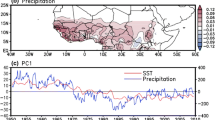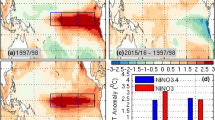Abstract
The 2009–2010 El Niño event was a moderately strong Central Pacific type ENSO and, as such, expected to lead to a substantial drought over southern Africa during austral summer. However, many parts of the region experienced average to well above average rainfall during this season. Given that seasonal forecasting skill tends only to be good during ENSO seasons and many parts of the sub-continent rely on rain-fed agriculture, understanding why the rainfall was so anomalous during this El Niño event is important. To this end, a global stretched grid atmospheric general circulation model with relatively high horizontal resolution of 0.5° × 0.5° is applied over the region with observed and idealised SST forcing. In the latter experiments, SSTs are kept as observed over one ocean basin (e.g. Pacific) and as climatology over the other two basins (e.g. Atlantic, Indian), or as climatology over one basin and as observed over the other two basins in order to help understand which of these three basins may have contributed most to the observed rainfall anomalies in summer 2009–2010. It is found that Pacific Ocean forcing contributed to the summer rainfall anomalies over most regions of southern Africa with the Atlantic acting to oppose the effects of the Pacific. However, over Mozambique, and to some extent Zimbabwe, the Indian Ocean was more important with the Atlantic again acting in opposition. The increased rainfall over most of southern Africa appears mainly due to a stronger Angola Low circulation system and to anomalously strong moisture flux from the tropical western Indian Ocean and, to lesser extent, the tropical South East Atlantic Ocean.

















Similar content being viewed by others
References
Abiodun B, Prusa J, Gutowski W (2008) Implementation of a non-hydrostatic, adaptive-grid dynamics core in CAM3. Part I: comparison of dynamics cores in aqua-planet simulations. Clim Dyn 31:795–810
Abiodun BJ, Gutowski WJ, Abatan AA, Prusa JM (2011) CAM-EULAG: A non-hydrostatic atmospheric climate model with grid stretching. Acta Geophys 59(6):1158
Archer ERM, Landman WA, Tadross MA, Malherbe J, Weepener H, Maluleke P, Marumbwa FM (2017) Understanding the evolution of the 2014–2016 summer rainfall seasons in southern Africa: Key lessons. Clim Risk Manag 16:22–28. https://doi.org/10.1016/j.crm.2017.03.006
Behera SK, Yamagata T (2001) Subtropical SST dipole events in the southern Indian Ocean. Geophys Res Lett 28:327–330
Blamey RC, Kolusu SR, Mahlalela P, Todd MC, Reason CJC (2018) The role of regional circulation features in regulating El Niño climate impacts over southern Africa: a comparison of the 2015/16 drought with previous events. Int J Climatol. https://doi.org/10.1002/joc.5668
Bolvin DT, Adler RF, Huffman GJ, Nelkin EJ, Poutiainen JP (2009) Comparison of GPCP monthly and daily precipitation estimates with high-latitude gauge observations. J Appl Meteorol Climatol 48:1843–1857
Collins WD, Rasch PJ, Boville BA, Hack JJ, McCaa JR, Williamson DL, Kiehl JT, Briegleb B, Bitz C, Lin S, Zhang M (2006) The formulation and atmospheric simulation of the Community Atmosphere Model version 3 (CAM3). J Climate 19:2144–2161
Compo GP, Whitaker JS, Sardeshmukh PD, Matsui N, Allan R, Yin X, Gleason B, Vose R, Rutledge G, Bessemoulin P (2011) The twentieth century reanalysis project. Quart J Roy Meteorol Soc 137:1–28
Cook C, Reason CJC, Hewitson BC (2004) Wet and dry spells within particular wet and dry summers in the South African summer rainfall region. Clim Res 26:17–31
Cretat J, Pohl B, Dieppois B, Berthou S, Pergaud J (2018) The Angola Low: relationship with southern African rainfall and ENSO. Clim Dyn. https://doi.org/10.1007/s00382-018-4222-3
D’Abreton P, Lindesay J (1993) Water vapour transport over southern Africa during wet and dry early and late summer months. Int J Climatol 13:151–170
D’Abreton P, Tyson P (1995) Divergent and non-divergent water vapour transport over southern Africa during wet and dry conditions. Meteorol Atmos Phys 55:47–59
Dee D, Uppala S, Simmons A, Berrisford P, Poli P, Kobayashi S, Andrae U, Balmaseda M, Balsamo G, Bauer P (2011) The ERA-Interim reanalysis: Configuration and performance of the data assimilation system. Quart J Roy Meteorol Soc 137:553–597
Driver P (2014) Rainfall variability over Southern Africa. Unpublished PhD thesis. University of Cape Town, Rondebosch, South Africa
Driver P, Reason CJC (2017) Variability in the Botswana High and its relationships with rainfall and temperature characteristics over southern Africa. Int J Climatol 37:570–581. https://doi.org/10.1002/joc.5022
Grabowski W, Smolarkiewicz P (2002) A multiscale anelastic model for meteorological research. Mon Weather Rev 130:939–956
Hack JJ, Caron JM, Yeager SG, Olson KW, Holland MM, Truesdale JE, Rasch PJ (2006) Simulation of the global hydrological cycle in the CCSM Community Atmospheric Model version 3. Mean features. J Clim 19(CAM3):2199–2221
Hansingo K, Reason CJC (2009) Modelling the atmospheric response over southern Africa to SST forcing in the southeast tropical Atlantic and southwest subtropical Indian Oceans. Int J Climatol 29:1001–1012
Harris I, Jones P, Osborn T, Lister D (2013) Updated high-resolution grids of monthly climatic observations—the CRU TS3.10 dataset. Int J Climatol 34:623–642
Harrison MSJ (1984) A generalized classification of South African summer rain-bearing synoptic systems. J Climatol 4:547–560
Hart NCG, Reason CJC, Fauchereau N (2010) Tropical-extratropical interactions over southern Africa: three cases of heavy summer season Rainfall. Mon Weather Rev 138:2608–2623
Hart NCG, Reason CJC, Fauchereau N (2013) Cloud bands over southern Africa: seasonality, contribution to rainfall variability and modulation by the MJO. Clim Dyn 41:1199–1212. https://doi.org/10.1007/s00382-012-1589-4
Hirst AC, Hastenrath S (1983) Atmosphere-ocean mechanisms of climate anomalies in the Angola-tropical Atlantic sector. J Phys Oceanogr 13:1146–1157
Hoell A, Funk C, Magadzire T, Zinke J, Husak G (2015) El Niño Southern Oscillation diversity and southern Africa teleconnections during austral summer. Clim Dyn 45:1583–1599
Hoell A, Funk C, Zinke J, Harrison L (2017) Modulation of the Southern Africa precipitation response to the El Niño Southern Oscillation by the subtropical Indian Ocean Dipole. Clim Dyn 48:2529–2540
JFM (2010) January, February, March
Kao HY, Yu JY (2009) Contrasting eastern-Pacific and central-Pacific types of ENSO. J Climate 22:615–632
Kim W, Yeh SW, Kim JH, Kug JS, Kwon M (2011) The unique 2009–2010 El Niño event: a fast phase transition from warm pool El Niño to La Niña. Geophys Res Lett 38:15
Landman W, Beraki A (2012) Multi-model forecast skill for mid-summer rainfall over southern Africa. Int J Climatol 32:303–314
Lee T, McPhaden MJ (2010) Increasing intensity of El Niño in the central-equatorial Pacific. Geophys Res Lett 37:14
Lindesay JA (1988) South African rainfall, the Southern Oscillation and a Southern Hemisphere semi-annual cycle. J Climatol 8:17–30
Lipps FB, Hemler RS (1982) A scale analysis of deep moist convection and some related numerical calculations. J Atmos Sci 39:2192–2210
Lipps FB, Hemler RS (1986) Numerical simulation of deep tropical convection associated with large-scale convergence. J Atmos Sci 43:1796–1816
Lyon B, Mason SJ (2007) The 1997–98 summer rainfall season in Southern Africa. Part I: observations. J Climate 20:5134–5148. https://doi.org/10.1175/JCLI4225.1
Maoyi ML, Abiodun BJ, Prusa JM, Veitch JJ (2018) Simulating the characteristics of tropical cyclones over the South West Indian Ocean using a Stretched-Grid Global Climate Model. Clim Dyn 50(5–6):1581–1596
Mason SJ (1995) Sea-surface temperature—South African rainfall associations, 1910–1989. Int J Climatol 15:119–135
Matarira CH (1990) Drought over Zimbabwe in a regional and global context. Int J Climatol 10:609–625
Mulenga HM, Rouault M, Reason CJC (2003) Dry summers over NE South Africa and associated circulation anomalies. Clim Res 25:29–41
Munday C, Washington R (2017) Circulation controls on southern African precipitation in coupled models: the role of the Angola Low, J Geophys ResAtmos. https://doi.org/10.1002/2016JD025736
Nicholson SE, Kim J (1997) The relationship of the El Niño – Southern Oscillation to African rainfall. Int J Climatol 17:117–135
OND (2009) October, November, December
Prusa J, Smolarkiewicz P, Wuszogrodzki A (2008) EULAG, a computational model for multiscale flows. Comput Fluids 37:1193–1207
Ratnam J, Behera S, Masumoto Y, Takahashi K, Yamagata T (2012) Anomalous climatic conditions associated with the El Niño Modoki during boreal winter of 2009. Clim Dyn 39:227–238
Ratnam J, Behera S, Masumoto Y, Yamagata T (2014) Remote effects of El Niño and Modoki events on the austral summer precipitation of southern Africa. J Clim 27:3802–3815
Reason CJC (1998) Warm and cold events in the southeast Atlantic/southwest Indian Ocean region and potential impacts on circulation and rainfall over southern Africa. Meteorol Atmos Phys 69:49–65
Reason CJC (2001) Subtropical Indian Ocean SST dipole events and southern African rainfall. Geophys Res Lett 28:225–228
Reason CJC (2002) Sensitivity of the southern African circulation to dipole SST patterns in the South Indian Ocean. Int J Climatol 22:377–393
Reason CJC (2016) The bolivian, botswana and bilybara highs and Southern Hemisphere drought/floods. Geophys Res Lett 43:1280–1286. https://doi.org/10.1002/2015GL067228
Reason CJC, Jagadheesha D (2005) A model investigation of recent ENSO impacts over southern Africa. Meteorol Atmos Phys 89:181–205. https://doi.org/10.1007/s00703-005-0128-9 (Special Issue on Regional Climate)
Reason CJC, Mulenga HM (1999) Relationships between South African rainfall and SST anomalies in the South West Indian Ocean. Int J Climatol 19:1651–1673
Reason CJC, Allan RJ, Lindesay JA, Ansell TJ (2000) ENSO and climatic signals across the Indian Ocean basin in the global context: Part I, interannual composite patterns. Int J Climatol 20:1285–1327
Reason CJC, Landman W, Tennant W (2006) Seasonal to decadal prediction of southern African climate and its links with variability of the Atlantic Ocean. Bull Am Meteorol Soc 87:941–955
Reynolds RW, Smith TM, Liu C, Chelton DB, Casey KS, Schlax MG (2007) Daily high-resolution-blended analyses for sea surface temperature. J Clim 20:5473–5496
Rouault M, Florenchie P, Fauchereau N, Reason CJC (2003) South East Atlantic warm events and southern African rainfall. Geophys Res Lett 30(5):8009. https://doi.org/10.1029/2002GL014840
Saji NH, Goswami BN, Vinayachandran PN, Yamagata T (1999) A dipole mode in the tropical Indian ocean. Nature 401:360–363
Todd MC, Washington R (1998) Extreme daily rainfall in southern African and southwest Indian Ocean tropical-temperate links. S Afr J Sci 94:64–70
Vigaud N, Richard Y, Rouault M, Fauchereau N (2009) Moisture transport between the South Atlantic Ocean and southern Africa: relationships with summer rainfall and associated dynamics. Clim Dyn 32:113–123
Walker ND (1990) Links between South African summer rainfall and temperature variability of the Agulhas and Benguela current systems. J Geophys Res 95:3297–3319
Xie P, Arkin PA (1997) Global precipitation: A 17-year monthly analysis based on gauge observations, satellite estimates and numerical model outputs. Bull Am Meteorol Soc 78:2539–2558
Yeh, S.W., J.S. Kug, B. Dewitte, M.H. Kwon, B.P. Kirtman and F.F. Jin, 2009: El Niño in a changing climate. Nature 461:511–514
Zhang GJ, McFarlane NA (1995) Sensitivity of climate simulations to the parameterization of cumulus convection in the Canadian Climate Centre general circulation model. Atmos Ocean 33(3):407–446
Zhang Q, Kornich H, Holmgren K (2013) How well do reanalyses represent the southern African precipitation? Clim Dyn 40:951–962
Acknowledgements
The first author gratefully acknowledges PhD scholarship funding from the South African National Research Foundation ACCESS programme, and the University of Cape Town. J. Prusa gave invaluable technical help to the first author in implementing the CEU model. The authors declare that they have no conflict of interest.
Author information
Authors and Affiliations
Corresponding author
Rights and permissions
About this article
Cite this article
Driver, P., Abiodun, B. & Reason, C.J.C. Modelling the precipitation response over southern Africa to the 2009–2010 El Niño using a stretched grid global atmospheric model. Clim Dyn 52, 3929–3949 (2019). https://doi.org/10.1007/s00382-018-4362-5
Received:
Accepted:
Published:
Issue Date:
DOI: https://doi.org/10.1007/s00382-018-4362-5




